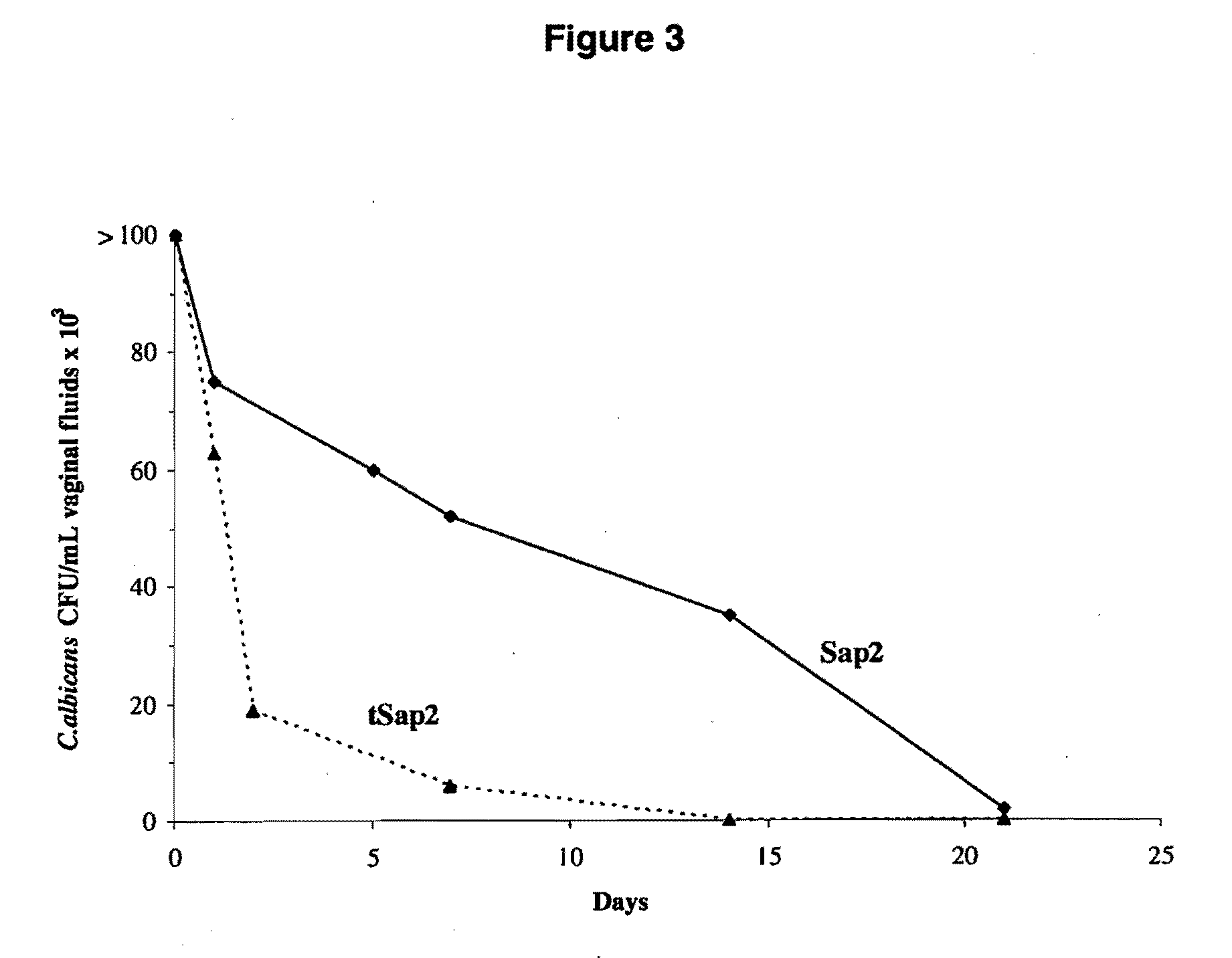Truncated secretory aspartyl proteinase 2
a proteinase and secretory aspartyl technology, applied in the direction of peptide/protein ingredients, dna/rna fragmentation, depsipeptides, etc., can solve the problem of poor choice of vaccines
- Summary
- Abstract
- Description
- Claims
- Application Information
AI Technical Summary
Benefits of technology
Problems solved by technology
Method used
Image
Examples
example 1
Materials and Methods
1.1 Microorganisms and Growth Conditions
[0125]C. albicans ATCC20955 was used as a fungal DNA source in this study. It was grown in Winge (0.3% yeast extract, 0.2% glucose, Difco). Escherichia coli M15 (nals, strs, rifs, lac−, ara−, gal−, mtl−, F−, recA+, uvr+, [pUHA1]) was used as host strains for recombinant plasmids. E. coli cells were typically grown in LB-broth (1% tryptone, 0.5% yeast extract, 0.5 NaCl, pH 7.00) or LB-plates (1% tryptone, 0.5% yeast extract, 0.5% NaCl, 1.5% agar, pH 7.00) supplemented when necessary with ampicillin (50 mg ml−1), kanamycin (50 mg ml−1) (Boehringer). C. albicans SA-40 initially isolated from the vaginal secretion of a subject with acute vaginitis was used for experimental vaginitis. The modalities of fungal growth, induction and assessment of experimental vaginal infection in oophorectomized rats were as previously described (Cassone A. et al., Infect. Immun. (1995), 63: 2619-2624; De Bernardis F. et al., Infect. Immun. (1997...
example 2
2.1 Construction of Recombinant Plasmids and Production of Truncated Recombinant Sap2 (tSap2)
[0128]Full-length SAP was cloned as described in Example 1. For the production of a truncated form of Sap2, plasmid pRLV141 was digested with BamHI to excise the fragment corresponding to the nucleotides encoding amino acids 1-76 of SAP2 coding sequence. The digested plasmid was re-ligated to give pRLV143 and used to transform the bacterial cells. The resulting colonies were analyzed for DNA insert length by restriction mapping, PCR and DNA sequencing (data not shown).
[0129]Alternatively a truncated Sap2 including the His-tag and with an additional protease cleavage site (thrombin) between the His-tag and tSap2 was produced synthetically (Geneart, Regensburg, Germany). For optimal expression in a host system the codon usage was adapted to the host's codon usage (e.g. by Geneart, Regensburg, Germany). The tSap2 gene was synthesized with the two restriction sites Ndel (5′ end) and BamHI (3′ en...
example 3
Stability of Recombinant Sap and tSap2
[0137]Recombinant Sap2 and tSap2 were expressed and purified as described in Example 1 and 2. 3 μg of recombinant Sap2 and tSap2 were incubated in PBS for different lengths of time (30 min to 24 or 48 hours) either at room temperature or at 37° C. After incubation, both preparations were subjected to SDS-PAGE and stained with Coomassie Blue.
[0138]The truncated recombinant Sap2 was fully stable and fully reactive with the anti-Sap2 serum for 24 hours (FIG. 1A) and 48 hours (data not shown), without any sign of degradation. Following incubation at RT (at 37° C.), this protein preparation was also very stable and showed only little degradation with serum-reactive low-molecular weight bands at 24-48 hours. In contrast, the wild type Sap2 preparation was labile following incubation for 6 to 24 hours even at room temperature and totally degradable even after short, 30 min incubation at 37° C. (FIG. 1B).
PUM
| Property | Measurement | Unit |
|---|---|---|
| temperature | aaaaa | aaaaa |
| pH | aaaaa | aaaaa |
| pH | aaaaa | aaaaa |
Abstract
Description
Claims
Application Information
 Login to View More
Login to View More - R&D
- Intellectual Property
- Life Sciences
- Materials
- Tech Scout
- Unparalleled Data Quality
- Higher Quality Content
- 60% Fewer Hallucinations
Browse by: Latest US Patents, China's latest patents, Technical Efficacy Thesaurus, Application Domain, Technology Topic, Popular Technical Reports.
© 2025 PatSnap. All rights reserved.Legal|Privacy policy|Modern Slavery Act Transparency Statement|Sitemap|About US| Contact US: help@patsnap.com



